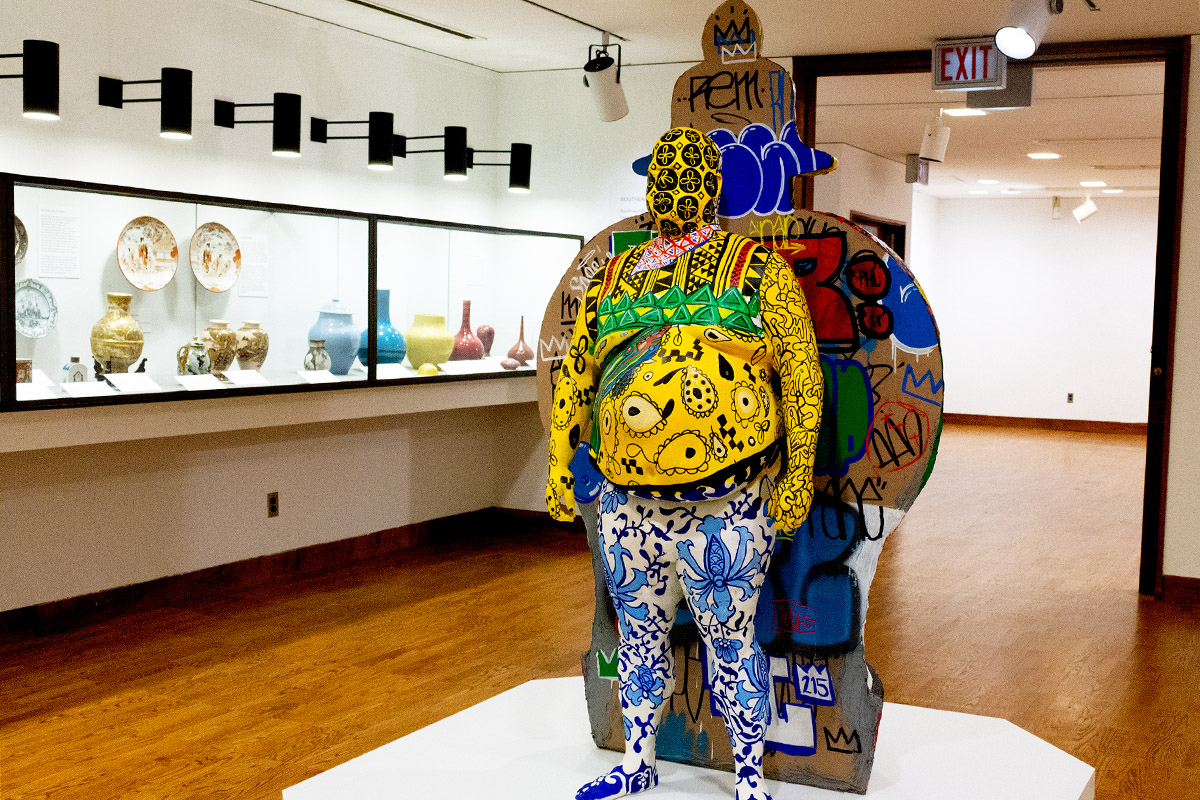
Krannert Art Museum has reinstalled its Moore Gallery of Decorative Arts to highlight new acquisitions and tell the stories of diverse artists, as well as examine the history of decorative arts collecting. The centerpiece of the gallery is a large sculpture by Roberto Lugo that integrates global ceramic traditions with imagery from contemporary urban life.
Roberto Lugo, "Yo Soy Boricua: A DNA Study," 2019. Resin, acrylic paint, chalk and MDF. Museum purchase through the John N. Chester Fund. 2022-15-1
Courtesy Krannert Art Museum
CHAMPAIGN, Ill. — Krannert Art Museum has completed a transformation of its Moore Gallery of Decorative Arts that highlights several new acquisitions and the diverse stories of art-making they tell, while examining histories of decorative arts collecting by museum donors and the University of Illinois Urbana-Champaign.
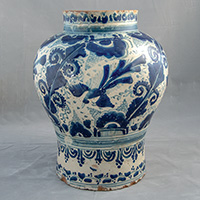
The vase portion of the Roberto Lugo sculpture in KAM's decorative arts gallery mirrors the shape of traditional forms such as this Talavera vase.
Talavera Poblana Tibor, Puebla de los Angeles Mexico, ca. 1700. Tin-glazed ceramic. Museum purchase through the Theresa E. and Harlan E. Moore Charitable Trust Fund. 2022-13-1
Courtesy Krannert Art Museum
The centerpiece of "Well-designed Beauty: Trade, Technology, and Decorative Arts" is a contemporary work designed to make an impact and a statement about art history – a large sculpture by artist Roberto Lugo with a life-sized cast of Lugo's body positioned against a sheared-off side of a giant vase. The sculpture, "Yo Soy Boricua: A DNA Study," was acquired with a grant from the U. of I.'s John N. Chester endowment fund. "Boricua" is a person from Puerto Rico, either by birth or descent. Lugo's parents were first-generation immigrants from Puerto Rico who raised him in Philadelphia.
Although he started out as a graffiti artist, Lugo now practices as a ceramicist, social activist and art professor at Temple University. In this sculpture, Lugo integrates patterns derived from European and Asian ceramic traditions with those from contemporary urban life, such as graffiti tags, hip-hop and street culture.
"Some imagery comes from Lugo's background as a graffiti artist, such as his inclusion of the tags – stylized signatures – of his teacher and of his brother, Maz. The paisley pattern evokes the bandannas worn by gang members in his neighborhood in Philadelphia. The colorful geometric patterns across the chest are like the ones on COOGI sweaters, which were popular in the 1990s with rappers and hip-hop stars," said Maureen Warren, the exhibition curator and KAM's curator of European and American art.
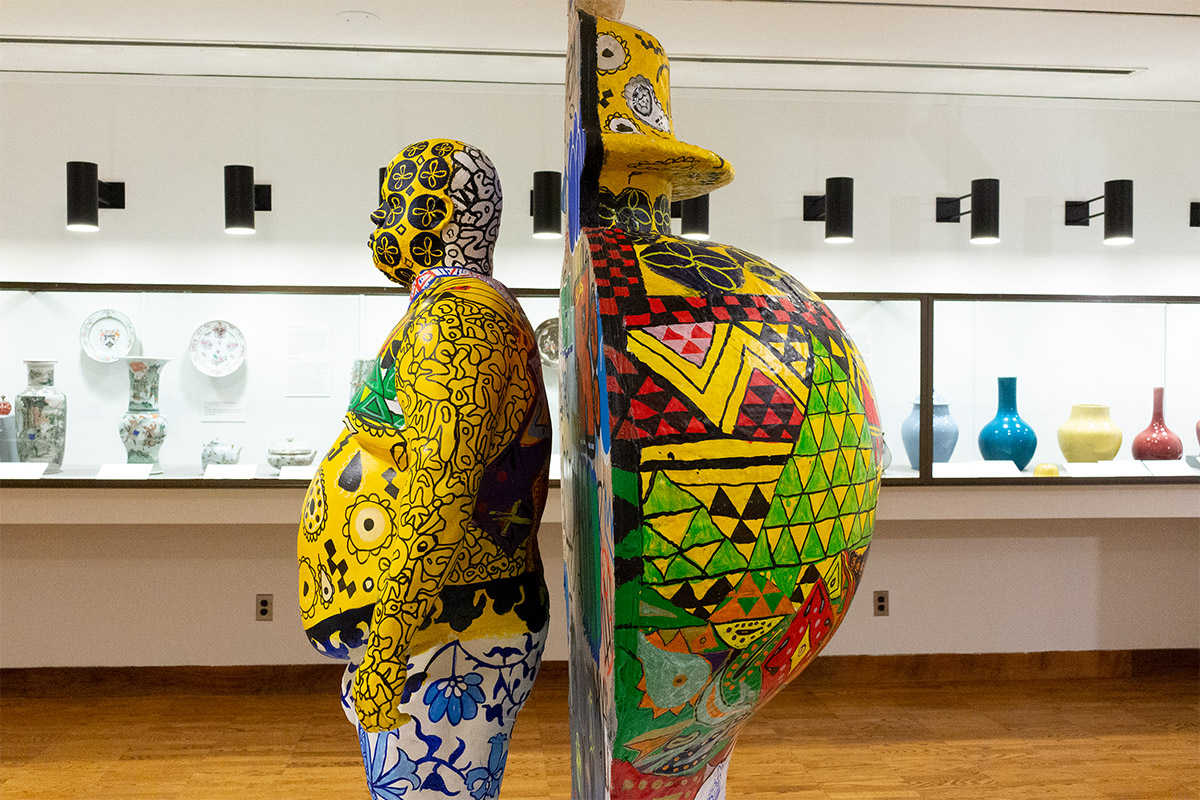
Roberto Lugo, "Yo Soy Boricua: A DNA Study," 2019. Resin, acrylic paint, chalk and MDF. Museum purchase through the John N. Chester Fund. 2022-15-1
Courtesy Krannert Art Museum
Stephen Signa-Aviles, an art professor and sculpture artist, said he immediately connected with Lugo's sculpture.
"I was absolutely floored and thrilled to see a work like that in KAM," Signa-Aviles said. "The imagery and subject matter he's using have a lot of similarity and kinship to the work I'm doing. Our visual languages are very similar."
Signa-Aviles said he was struck by the beauty and energy of the patterns Lugo used and the subtleties of the work.
"Lugo's work reflects a specificity of place, while my work grapples with the absence of stories about my Mexican ancestry and identity. But both of us are taking art-making canons and injecting narratives about our identities as people of color," said Signa-Aviles, who is Mexican American.
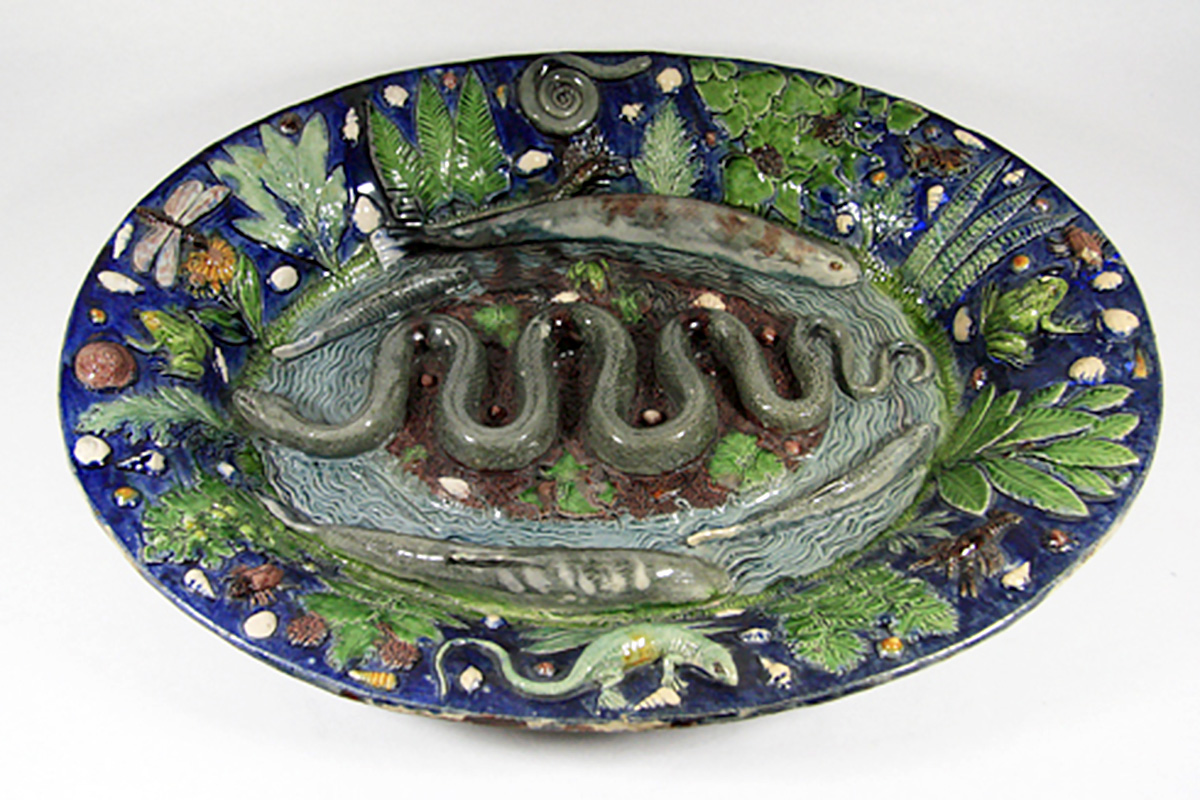
The museum made several recent acquisitions through the Theresa E. and Harlan E. Moore endowment fund, including a 16th-century French Renaissance ceramic platter that features a snake in the platter's center and fish and frogs around the edge, all of which were made from casts of the bodies of the dead animals.
Bernard Palissy (att.), Platter, ca. 1510-1589. Lead-glazed earthenware. Museum purchase through the Theresa E. and Harlan E. Moore Charitable Trust Fund. 1988-10-1
Courtesy Krannert Art Museum
KAM's decorative arts collection includes many works made by people of color and women, for whom the decorative arts industry – utilitarian items celebrated for their beauty and craftsmanship – historically was more accessible than were fine arts studios, Warren said.
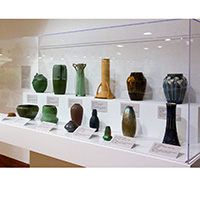
Much of the American Arts and Crafts pottery at KAM was made by women. The works on display in the decorative arts gallery were a gift from the former ceramic engineering department.
"Well-designed Beauty: Trade, Technology, and Decorative Arts," installation view at Krannert Art Museum, University of Illinois Urbana-Champaign, 2022.
Photo by Julia Nucci Kelly
KAM's collection demonstrates the technological advances in decorative arts, particularly in glassware and ceramics, Warren said. The museum has a strong collection of American pottery, much of it donated from a museum in the former ceramic engineering department, now known as materials science and engineering. The department had hoped the museum would inspire new ceramic and building material technologies to support Illinois industry, Warren said, and "they felt it was important for students to see examples of fine arts ceramics as part of that training."
The decorative arts gallery displays major examples of American Arts and Crafts pottery from that gift. The objects often were ornately designed or decorated, reflecting a desire for handmade objects with an artisan sensibility, and the artists, many of them women, experimented with glaze and decoration techniques, Warren said.
In addition to the engineering gift, many works in the gallery were purchased through the Theresa E. and Harlan E. Moore endowment fund, which provides money not only for purchases but also to conserve decorative arts. Theresa Moore, who also donated her art collection, is one of several female benefactors, including Ellnora Krannert, who have had a significant impact on the arts at the U. of I., Warren said.
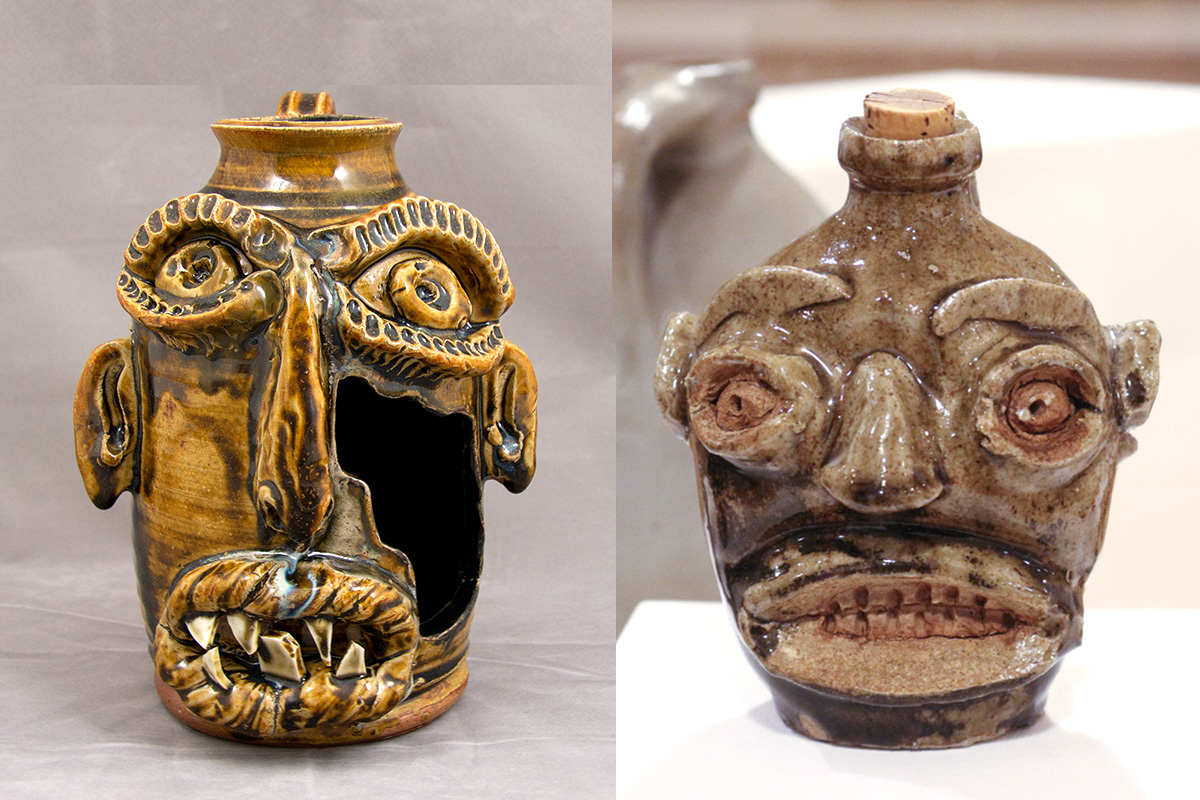
The decorative arts collection includes contemporary and historic face jugs.
Left, Jim McDowell, "Disappearing Black Man," 2021. Gas-fired stoneware with amber celadon glaze and pieces of broken porcelain. Museum purchase through the Theresa E. and Harlan E. Moore Charitable Trust Fund. 2021-16-1
Right, Unknown artist, Face Jug, ca. 1850-1865. Museum purchase through the Theresa E. and Harlan E. Moore Charitable Trust Fund. 2018-15-1
Courtesy Krannert Art Museum
The gallery includes historical and contemporary face jugs purchased with the Moore fund. KAM's historical stoneware face vessel was made by an unknown enslaved artist in Edgefield, South Carolina, between 1850 and 1865. A face vessel by contemporary stoneware artist Jim McDowell is called "Disappearing Black Man" and references both McDowell's family history as the descendant of enslaved people and the face vessels created by Black potters in 19th-century Edgefield.
"McDowell is asking the viewer to look for the contributions of Black Americans that are forgotten or appropriated. Writing on the vessel is a challenge to the viewer: 'If I disappeared, would you look for me?'" Warren said.
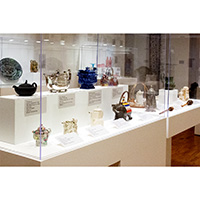
A collection of teapots illustrates the changes in the price of tea. Teapots were quite small when tea was very expensive, and they grew larger as tea became cheaper. KAM's collection includes several teapots in the shape of animals.
"Well-designed Beauty: Trade, Technology, and Decorative Arts," installation view at Krannert Art Museum, University of Illinois Urbana-Champaign, 2022.
Photo by Julia Nucci Kelly
The gallery also includes a display of tea and coffee service from around the world, Chinese porcelain, European and North American blue-and-white ceramics, and historic and contemporary glass art. One important acquisition is a rare Korean moon jar, with a white glaze and large, spherical form. Korean artists celebrated the flaws in nature and the human condition through their ceramics, creating crackled glazes and forms that seemed to defy gravity, distinguishing it from other East Asian forms, Warren said.
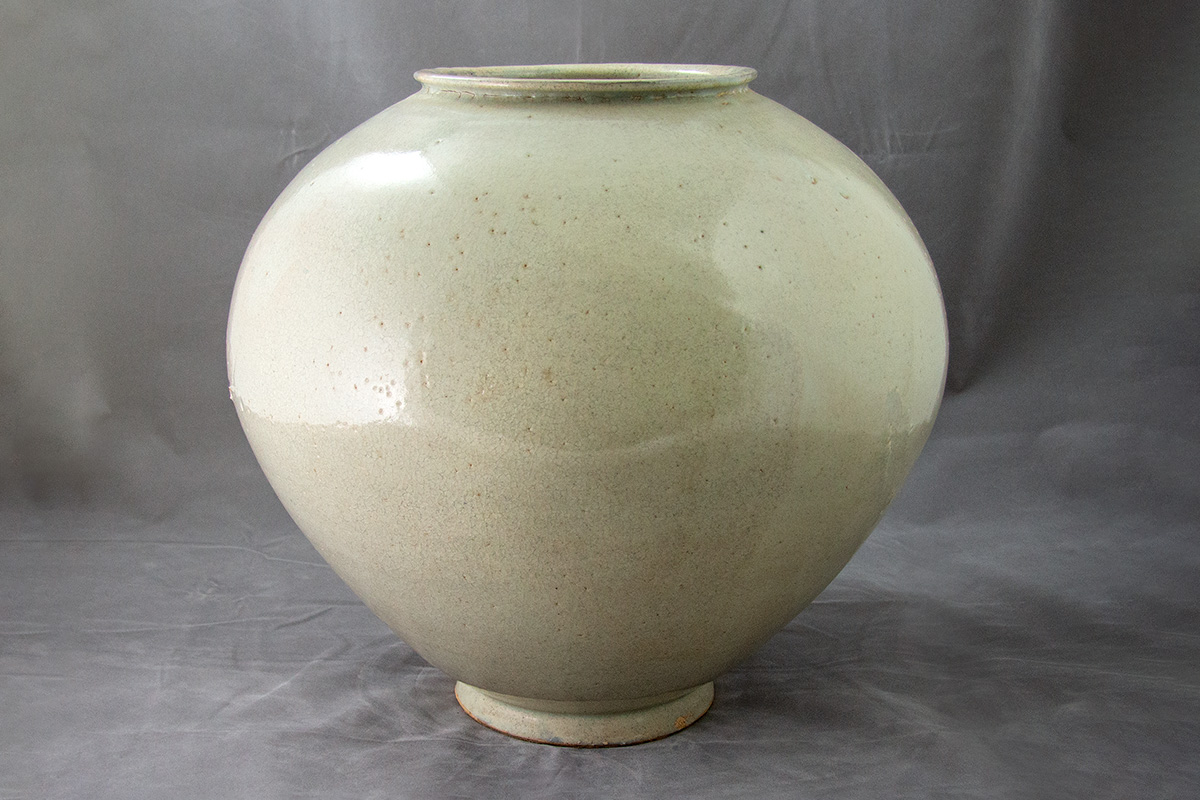
The crackled glaze of the Korean moon jar celebrates the flaws in nature and the human condition.
Moon Jar, Korea, Joseon dynasty, 18th century. Porcelain with crackled glaze. Museum purchase through the Iver M. Nelson Jr. Fund. 2022-1-1
Courtesy Krannert Art Museum
"I hope this new installation changes some assumptions about decorative arts," Warren said. "The technologies, collecting histories and stylistic elements from the decorative arts of the past have stories to tell, from a design perspective and a social historical one."






